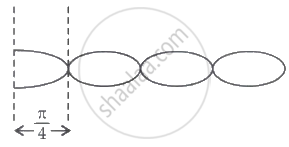Advertisements
Advertisements
प्रश्न
Two travelling waves produce a standing wave represented by the equation. y = 1.0 mm cos (1.57 cm-1) x sin (78.5 s-1)t. The node closest to the origin in the region x > 0 will be at x = ______ cm.
विकल्प
1
2
3
4
MCQ
रिक्त स्थान भरें
उत्तर
Two travelling waves produce a standing wave represented by the equation. y = 1.0 mm cos (1.57 cm-1) x sin (78.5 s-1)t. The node closest to the origin in the region x > 0 will be at x = 1 cm.
Explanation:
By comparing the given equation to the standing wave equation y = 2A cos kx sin ωt
Amplitude R = 2A cos kx
Given equation, y = 1.0 mm cos(1.5 cm-1) x sin(78.5)s-1)t

Comparing cos term,
k = `1.57 = (2pi)/lambda`
`lambda = (2pi)/1.57` cm
`lambda/4` is the closest node position to the origin.
= `(2pi)/(4 xx 1.57) = 1` cm
shaalaa.com
Reflection of Waves - Standing Waves and Normal Modes
क्या इस प्रश्न या उत्तर में कोई त्रुटि है?
